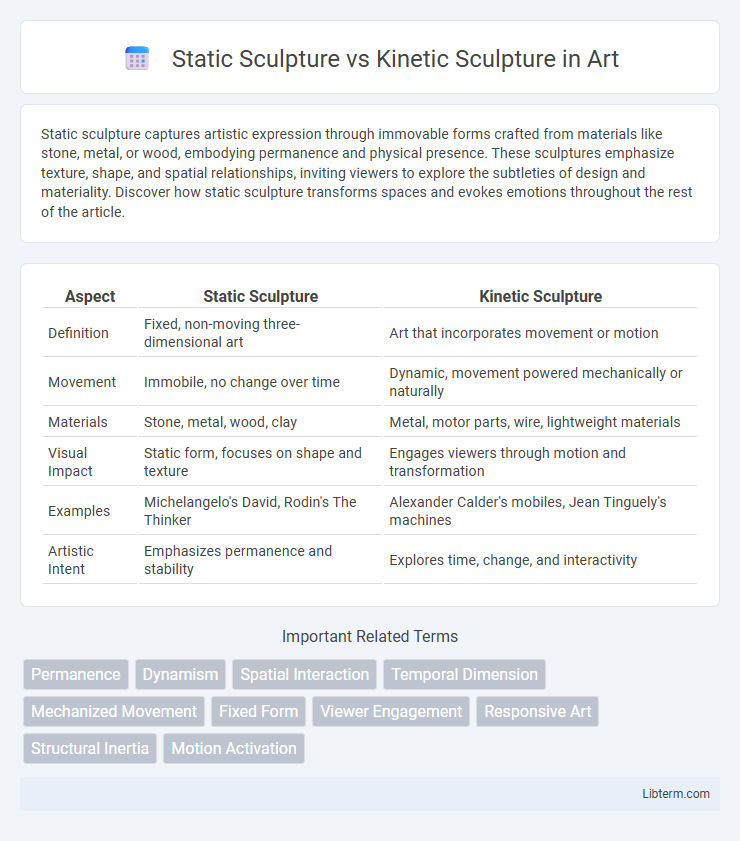Static sculpture captures artistic expression through immovable forms crafted from materials like stone, metal, or wood, embodying permanence and physical presence. These sculptures emphasize texture, shape, and spatial relationships, inviting viewers to explore the subtleties of design and materiality. Discover how static sculpture transforms spaces and evokes emotions throughout the rest of the article.
Table of Comparison
| Aspect | Static Sculpture | Kinetic Sculpture |
|---|---|---|
| Definition | Fixed, non-moving three-dimensional art | Art that incorporates movement or motion |
| Movement | Immobile, no change over time | Dynamic, movement powered mechanically or naturally |
| Materials | Stone, metal, wood, clay | Metal, motor parts, wire, lightweight materials |
| Visual Impact | Static form, focuses on shape and texture | Engages viewers through motion and transformation |
| Examples | Michelangelo's David, Rodin's The Thinker | Alexander Calder's mobiles, Jean Tinguely's machines |
| Artistic Intent | Emphasizes permanence and stability | Explores time, change, and interactivity |
Introduction to Static and Kinetic Sculpture
Static sculpture embodies form and mass through fixed, immobile materials such as stone, bronze, or wood, emphasizing shape, texture, and spatial presence. Kinetic sculpture incorporates movement, often powered by wind, motors, or viewer interaction, creating dynamic visual experiences that change over time. Both forms explore the relationship between art and space, but kinetic sculpture uniquely integrates motion as a fundamental element of its artistic expression.
Defining Static Sculpture: Characteristics and Examples
Static sculpture is defined by its immobility and permanence, often crafted from durable materials such as marble, bronze, or stone, designed to be viewed from multiple angles without any movement. Characteristics include a solid, stable form that emphasizes texture, shape, and spatial presence, exemplified by Michelangelo's "David" and Auguste Rodin's "The Thinker." These sculptures engage viewers through their intricate details and structural composition, maintaining a constant physical state over time.
Understanding Kinetic Sculpture: Features and History
Kinetic sculpture incorporates movement, using motors, wind, or human interaction to transform visual experience, contrasting with static sculptures that remain fixed in form. Originating in the early 20th century, artists like Alexander Calder pioneered mobiles, emphasizing dynamic balance and motion as integral artistic elements. This evolving art form merges engineering and creativity, highlighting time and change as essential to the sculpture's aesthetic and conceptual impact.
Materials and Techniques in Static Sculpture
Static sculptures primarily use durable materials such as stone, metal, wood, and clay, chosen for their ability to withstand environmental conditions and maintain form over time. Techniques in static sculpture often involve carving, modeling, casting, and assembling, emphasizing precision and permanence to create stable, non-moving artworks. The focus on material strength and intricate craftsmanship ensures that static sculptures convey a lasting physical and aesthetic presence.
Motion and Mechanics in Kinetic Sculpture
Kinetic sculpture incorporates movement as a fundamental element, utilizing mechanical systems such as gears, motors, and wind-driven components to create dynamic interaction with its environment. Unlike static sculpture, which remains fixed and relies solely on visual form, kinetic art emphasizes motion, engaging viewers through changing perspectives and continuous transformation. The mechanics behind kinetic sculptures often include carefully engineered joints and balances designed to harness and control kinetic energy, making motion an integral part of the artistic expression.
Aesthetic Differences: Stillness vs. Movement
Static sculptures emphasize permanence and form through their unchanging, solid presence, often evoking contemplation and stability. Kinetic sculptures incorporate movement as a fundamental element, creating a dynamic interaction with space and viewers by shifting shapes, light, or balance. This contrast highlights how stillness in static works fosters introspection, while movement in kinetic art generates energy and continuous transformation in the aesthetic experience.
Notable Artists in Static and Kinetic Sculpture
Notable artists in static sculpture include Auguste Rodin, renowned for "The Thinker," and Henry Moore, celebrated for his abstract monumental bronze works. In kinetic sculpture, Alexander Calder pioneered the mobile with his innovative balance and movement in pieces like "Lobster Trap and Fish Tail." Jean Tinguely also significantly contributed to kinetic art through his mechanical sculptures that combine motion and sound.
Impact on Viewer Experience and Interpretation
Static sculptures offer a fixed form that encourages viewers to contemplate details, texture, and craftsmanship from multiple angles, creating a timeless and stable visual impact. Kinetic sculptures incorporate movement, engaging viewers dynamically and often evoking emotional responses through change and interaction, which can alter interpretation over time. The interplay between motion and stillness in kinetic art enhances sensory engagement and invites evolving perceptions, while static art emphasizes permanence and focused appreciation.
Installation Environments: Gallery vs. Public Spaces
Static sculptures thrive in controlled gallery environments where lighting, space, and viewer proximity are carefully managed to highlight intricate details and stable forms. Kinetic sculptures excel in public spaces due to their interactive elements and movement, engaging diverse audiences and responding to natural forces like wind or human interaction. The installation environment fundamentally influences the design, durability, and viewer experience of static versus kinetic sculptures.
Future Trends in Static and Kinetic Sculpture
Future trends in static sculpture emphasize integration with augmented reality (AR) and sustainable materials, enhancing viewer interaction without altering the artwork's physical state. Kinetic sculpture is evolving through advancements in robotics and AI, enabling more complex, responsive motion patterns influenced by environmental data and human presence. Both forms increasingly incorporate digital technology, blurring boundaries between traditional art and immersive, interactive experiences.
Static Sculpture Infographic

 libterm.com
libterm.com